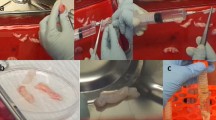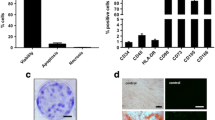Abstract
Even though umbilical cord arteries are a common source of vascular smooth muscle cells, the lack of reliable marker profiles have not facilitated the isolation of human umbilical artery smooth muscle cells (HUASMC). For accurate characterization of HUASMC and cells in their environment, the expression of smooth muscle and mesenchymal markers was analyzed in umbilical cord tissue sections. The resulting marker profile was then used to evaluate the quality of HUASMC isolation and culture methods. HUASMC and perivascular-Wharton’s jelly stromal cells (pv-WJSC) showed positive staining for α-smooth muscle actin (α-SMA), smooth muscle myosin heavy chain (SM-MHC), desmin, vimentin and CD90. Anti-CD10 stained only pv-WJSC. Consequently, HUASMC could be characterized as α-SMA+ , SM-MHC+ , CD10− cells, which are additionally negative for endothelial markers (CD31 and CD34). Enzymatic isolation provided primary HUASMC batches with 90–99 % purity, yet, under standard culture conditions, contaminant CD10+ cells rapidly constituted more than 80 % of the total cell population. Contamination was mainly due to the poor adhesion of HUASMC to cell culture plates, regardless of the different protein coatings (fibronectin, collagen I or gelatin). HUASMC showed strong attachment and long-term viability only in 3D matrices. The explant isolation method achieved cultures with only 13–40 % purity with considerable contamination by CD10+ cells. CD10+ cells showed spindle-like morphology and up-regulated expression of α-SMA and SM-MHC upon culture in smooth muscle differentiation medium. Considering the high contamination risk of HUASMC cultures by CD10+ neighboring cells and their phenotypic similarities, precise characterization is mandatory to avoid misleading results.




Similar content being viewed by others
References
Adelow C, Segura T, Hubbell JA, Frey P (2008) The effect of enzymatically degradable poly(ethylene glycol) hydrogels on smooth muscle cell phenotype. Biomaterials 29:314–326
Cairrao E, Santos-Silva AJ, Alvarez E, Correia I, Verde I (2009) Isolation and culture of human umbilical artery smooth muscle cells expressing functional calcium channels. In Vitro Cell Dev Biol Anim 45:175–184
Corrao S, La Rocca G, Lo IM, Corsello T, Farina F, Anzalone R (2013) Umbilical cord revisited: from Wharton’s jelly myofibroblasts to mesenchymal stem cells. Histol Histopathol 28:1235–1244
Dikovsky D, Bianco-Peled H, Seliktar D (2008) Defining the role of matrix compliance and proteolysis in three-dimensional cell spreading and remodeling. Biophys J 94:2914–2925
Farias VA, Linares-Fernandez JL, Penalver JL, Paya Colmenero JA, Ferron GO, Duran EL, Fernandez RM, Olivares EG, O’Valle F, Puertas A, Oliver FJ, Ruiz de Almodovar JM (2011) Human umbilical cord stromal stem cell express CD10 and exert contractile properties. Placenta 32:86–95
Karahuseyinoglu S, Cinar O, Kilic E, Kara F, Akay GG, Demiralp DO, Tukun A, Uckan D, Can A (2007) Biology of stem cells in human umbilical cord stroma: in situ and in vitro surveys. Stem Cells 25:319–331
Kisselbach L, Merges M, Bossie A, Boyd A (2009) CD90 Expression on human primary cells and elimination of contaminating fibroblasts from cell cultures. Cytotechnology 59:31–44
La Rocca G, Anzalone R, Corrao S, Magno F, Loria T, Lo IM, Di Stefano A, Giannuzzi P, Marasa L, Cappello F, Zummo G, Farina F (2009) Isolation and characterization of Oct-4+/HLA-G+ mesenchymal stem cells from human umbilical cord matrix: differentiation potential and detection of new markers. Histochem Cell Biol 131:267–282
Leik CE, Willey A, Graham MF, Walsh SW (2004) Isolation and culture of arterial smooth muscle cells from human placenta. Hypertension 43:837–840
Martin de Llano JJ, Fuertes G, Garcia-Vicent C, Torro I, Fayos JL, Lurbe E (2007) Procedure to consistently obtain endothelial and smooth muscle cell cultures from umbilical cord vessels. Transl Res 149:1–9
Moiseeva EP (2001) Adhesion receptors of vascular smooth muscle cells and their functions. Cardiovasc Res 52:372–386
Nanaev AK, Kohnen G, Milovanov AP, Domogatsky SP, Kaufmann P (1997) Stromal differentiation and architecture of the human umbilical cord. Placenta 18:53–64
Olafsson IH, Vilhjalmsson DT, Thormodsson FR (2012) Preparation of cultured human vascular cells. Methods Mol Biol 849:245–259
Orr AW, Hastings NE, Blackman BR, Wamhoff BR (2010) Complex regulation and function of the inflammatory smooth muscle cell phenotype in atherosclerosis. J Vasc Res 47:168–180
Owens GK, Kumar MS, Wamhoff BR (2004) Molecular regulation of vascular smooth muscle cell differentiation in development and disease. Physiol Rev 84:767–801
Pavlath GK, Gussoni E (2005) Human myoblasts and muscle-derived SP. Methods Mol Med 107:97–110
Rainger GE, Stone P, Morland CM, Nash GB (2001) A novel system for investigating the ability of smooth muscle cells and fibroblasts to regulate adhesion of flowing leukocytes to endothelial cells. J Immunol Methods 255:73–82
Rensen SS, Doevendans PA, van Eys GJ (2007) Regulation and characteristics of vascular smooth muscle cell phenotypic diversity. Neth Heart J 15:100–108
Sartore S, Chiavegato A, Faggin E, Franch R, Puato M, Ausoni S, Pauletto P (2001) Contribution of adventitial fibroblasts to neointima formation and vascular remodeling: from innocent bystander to active participant. Circ Res 89:1111–1121
Shi X, DiRenzo D, Guo LW, Franco SR, Wang B, Seedial S, Kent KC (2014) TGF-b/Smad3 stimulates stem cell/developmental gene expression and vascular smooth muscle cell de-differentiation. PLoS One 9(4):e93995
Soofi SS, Last JA, Liliensiek SJ, Nealey PF, Murphy CJ (2009) The elastic modulus of Matrigel as determined by atomic force microscopy. J Struct Biol 167:216–219
Stegemann JP, Hong H, Nerem RM (2005) Mechanical, biochemical, and extracellular matrix effects on vascular smooth muscle cell phenotype. J Appl Physiol 98:2321–2327
Acknowledgments
The authors want to thank Nicole Kronimus for support in cell isolation, Hannes Zwickl and Florian Halbwirt for their help and advice in 3D cell culture, Kerstin Hingerl for performing the immunohistochemistry, Carla Tripisciano and Michael Fischer for their help in publication work.
Author information
Authors and Affiliations
Corresponding author
Rights and permissions
About this article
Cite this article
Mazza, G., Roßmanith, E., Lang-Olip, I. et al. Marker profile for the evaluation of human umbilical artery smooth muscle cell quality obtained by different isolation and culture methods. Cytotechnology 68, 701–711 (2016). https://doi.org/10.1007/s10616-014-9822-0
Received:
Accepted:
Published:
Issue Date:
DOI: https://doi.org/10.1007/s10616-014-9822-0




